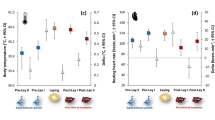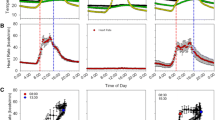Summary
Behavioural activity, and core and surface temperatures of 4 unrestrained Galapagos fur seals were recorded in the natural habitat during their first weeks of life. Climatic variables were registered simultaneously. Pup behaviours were divided into bouts of resting (55% of total time), sucking (23%) and other activities (22%). Pups maintained a constant body temperature from their first day. Core temperature (T e ) was 37.7° C±0.3° C (x ± SD) over 39 pup-days and 8 pup-nights. Skin temperature was correlated with T c , but flipper temperature was not. No daily T c rhythm was detected. Microclimate data were used to calculate operative temperature T e . Environmental temperatures can be very high, with T e above T c 6–9 h a day for animals exposed to the sun, but below it in the shade. T c is about 22° C at night. Pups avoid overheating mainly by withdrawing into the shade and reducing activity to a minimum during the hot hours of the day. Sun-exposed pups could be active at any time during the day if they had access to water, which was usually around high tide.
Similar content being viewed by others
References
Arnold W, Trillmich F (1985) Time budget in Galapagos fur seal pups: the influence of the mother's presence and absence on pup activity and play. Behaviour 92:302–321
Aschoff J (1982) The circadian rhythm of body temperature as a function of body size. In: Taylor CR, Johansen K, Bolis L (eds) A companion to animal physiology. Cambridge University Press, pp 137–188
Bakken GS (1976) A heat transfer analysis of animals: unifying concepts and the application of metabolism chamber data to field ecology. J Theor Biol 60:337–384
Bartholomew GA (1964) The role of physiology and behavior in the maintenance of homeostasis in the desert environment. Symp Soc Exp Biol 18:7–29
Bartholomew GA, Wilke F (1956) Body temperature in the northern fur seal, Callorhinus ursinus. J Mammal 37:327–337
Bennett A, Huey R, John-Alder H, Nagy K (1984) The parasol tail and thermoregulatory behavior of the Cape ground squirrel Xenus inauris. Physiol Zool 57:57–62
Blix AS, Steen JB (1979) Temperature regulation in newborn polar homeotherms. Physiol Rev 59:285–304
Cane MA (1983) Oceanographic events during El Niño. Science 222:1189–1195
Chappell MA, Bartholomew GA (1981) Standard operative temperatures and thermal energetics of the Antelope ground squirrel Ammospermophilus leucurus. Physiol Zool 54:81–95
Colinvaux PA (1984) The Galapagos climate: present and past. In: Perry R (ed) Key Environments — Galapagos. Pergamon Press, Oxford, pp 55–69
Elsner R, Hammond DD, Denison DM, Wyburn R (1977) Temperature regulation in the newborn Weddell seal, Leptonychotes weddelli. In: Lano GA (ed) Adaptations within antarctic ecosystems. Smithsonian Institution, Washington DC, pp 531–540
Gates DM (1981) Biophysical Ecology, Springer, New York
Gentry RL (1972) Thermoregulatory behavior of eared seals. Behaviour 46:73–93
Hubbard RC (1968) Husbandry and laboratory care of pinnipeds. In: Harrison RJ, Hubbard RC, Peterson RS, Rice CE, Schusterman RJ (eds) The behavior and physiology of pinnipeds. Appleton-Century-Crofts, New York, pp 299–358
Irving L, Hart JS (1957) The metabolism and insulation of seals as bare-skinned mammals in cold water. Can J Zool 35:497–511
Irving L, Peyton LJ, Bahn CH, Peterson RS (1962) Regulation of temperature in fur seals. Physiol Zool 35:275–284
Lorenz D (1968) Temperature measurements of natural surfaces using infrared radiometers. Applied Optics 7:1705–1712
Matsuura DT, Whittow GC (1973) Oxygen uptake of the California sea lion and harbour seal during exposure to heat. Am J Physiol 225:711–715
McGinnis SM (1968) Biotelemetry in pinnipeds. In: Harrison RJ, Hubbard RC, Peterson RS, Rice CE, Schusterman RJ (eds) The behavior and physiology of pinnipeds. Appleton-Century-Crofts, New York, pp 54–68
Porter WP, Gates DM (1969) Thermodynamic equilibria of animals with environment. Ecol Monographs 39:245–270
Rasmusson EM, Wallace JM (1983) Meterological aspects of the El Niño/Southern oscillation. Science 222:1195–1202
Schmidt-Nielsen K (1964) Desert animals: physiological problems of heat and water. Clarendon Press, Oxford
Stevenson RD (1985) The relative importance of behavioral and physiological adjustments controlling body temperature in terrestrial ectotherms. Am Nat (in press)
Tarasoff FJ, Fisher HD (1970) Anatomy of the hindflippers of two species of seals with reference to thermoregulation. Can J Zool 48:821–829
Trillmich F (1984) Natural history of the Galapagos fur seal (Arctocephalus galapagoensis, Heller). In: Perry R (ed) Key Environments — Galapagos. Pergamon Press, Oxford, pp 215–223
Trillmich F, Limberger D (1985) Drastic effects of El Niño on Galapagos pinnipeds. Oecologia (Berlin) 67:19–22
White FN, Odell DK (1971) Thermoregulatory behavior of the northern elephant seal, Mirunga angustirostris. J of Mamm 52:758–774
Whittow GC, Ohata CA, Matsuura DT (1971) Behavioral control of body temperature in the unrestrained California sea lion. Comm Behav Biol 6:87–91
Whittow GC, Matsuura DT, Lyn YC (1972) Temperature regulation in the Californian sea lion Zalophus californianus. Phys Zool 45:68–77
Author information
Authors and Affiliations
Rights and permissions
About this article
Cite this article
Limberger, D., Trillmich, F., Biebach, H. et al. Temperature regulation and microhabitat choice by free-ranging Galapagos fur seal pups (Arctocephalus galapagoensis). Oecologia 69, 53–59 (1986). https://doi.org/10.1007/BF00399037
Received:
Issue Date:
DOI: https://doi.org/10.1007/BF00399037




